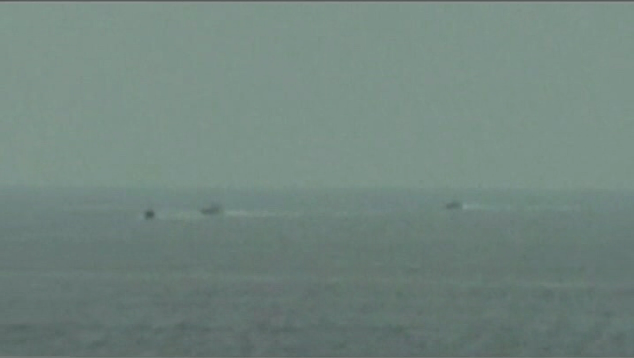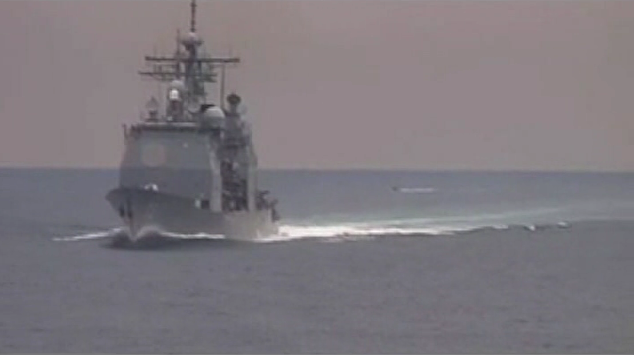This could be a group of good ole boys out for an afternoon on the lake, drinking beer and “buzzing” those who come from out of town for the summer with their big yachts, fancy cars and lake front condos. But as it turns out it is one of five similar open-air speed boats commanded by the Iranian Revolutionary Guard in the Strait of Hormuz, taking what President Bush characterized as “provocative” action against the U.S.S. Hopper. The Hopper is an 8,000 ton guided-missile destroyer equipped with M240 machine guns that fire 10 armor-piercing projectiles per minute, and on this particular day it was accompanied by two other guided-missile ships, including the U.S.S. Port Royal, a 9,000 ton cruiser that is capable of firing Tomahawk Missiles. If you ask me it wouldn’t be much of a fight, even if, as the Pentagon reports, the speed boats can carry machine guns. But, of course, if you are the Captain of a U.S. vessel in the Persian Gulf you probably can’t be too careful. And so the question is, how did this event become an “incident”? And what do the pictures that have been used to report the incident tell us about it?
The photograph, released by the U.S. Navy and featured by nearly all of the national news outlets tells us almost nothing. It could be a snapshot taken anywhere in the world, and so its value as visual evidence is virtually nil. Hence, the U.S. Navy also released a four minute, 20- second videotape taken from the deck of the Hopper which purports to contextualize the image above and thus corroborate the claim of provocative action. That videotape, however, is shot at long distance and shows very little. And what it does show is jumpy, grainy, and tonally muted:
Indeed, much of the imagery in the videotape recalls the photographs we were shown of the three North Vietnamese motor torpedo boats attacking the U.S.S. Maddox in the Gulf of Tonkin in 1964 and used as positive visual evidence to grant President Johnson the authority to deploy military forces in Vietnam. We now know that if there was a provocation in the Gulf of Tonkin that it was almost assuredly made by the Maddox, and so we have to be not only somewhat skeptical about the truth value of such photographs, but also about the ways in which they are used as visual arguments.
The Bush administration’s usage of the photographs from the Gulf of Hormuz to suggest that Iran is being provocative relies upon two optics or visual logics, one drawing upon a Cold War consciousness and the other drawing upon the logic of the “suicide bomber.” The Cold War optic recalls the ability of the modern, technologically sophisticated, military to observe the world from afar as a means of identifying and assessing threats to national security. Think here of Adlai Stevenson challenging Ambassador Zorin of the USSR with satellite photographs of missile silos in Cuba in 1962. Or more recently, of course, we have Colin Powell using similar photographic evidence to prove the existence of WMDs in Iraq. One case turned out to be true, the other false, but what is important is the underlying assumption of the positive truth content of such visual evidence which presumes to show what otherwise could not be seen. Of course, this is nonsense. Nevertheless, recent videotape from the Gulf of Hormuz operates in precisely this optic. Shot at great distance, we never actually see individuals, let alone incontrovertibly threatening behavior, but that actually works in the favor of the underlying optic of the Cold War logic, for in a sense it is what cannot ordinarily be seen that is the threat, and so the speed boats function as a cipher for a presumably hidden, greater menace.
In this instance, the threat that can’t be seen is animated by the more contemporary optic of the “suicide bomber.” Suicide bombers operate in the light of day, not the cloak of darkness (as was the myth of the Cold War spy). They can be anyone, and indeed, their very visibility makes them effectively invisible (hidden in plain sight), and thus all the more a threat. Add to this the discursive connection between “suicide bombers” and “Middle Eastern Islamic fanatics” and the picture of the speed boats takes on a somewhat different resonance. All the more so in the wake of the terrorist attack on the U.S.S. Cole perpetrated by Al-Qaeda, a self-professed terrorist organization, in 2000. And to accentuate the point the U.S. Navy added an audio recording to its version of the videotape that has someone threatening to bomb the Hopper. We are now told that the Navy doesn’t know where that voice came from and, indeed, cannot confirm that it came from the speedboats. And more recent videotape released by the Iranian government suggests that it is unlikely that it came from the speedboats. But, again, the point is that the photographs are framed within the optic of the suicide bomber that encourages the viewer to see the ordinary and everyday as threats.
The final question then, has to be, did the speedboats perpetrate a threatening and provocative action that would warrant treating this as an international incident – for that is clearly what the Bush administration seems to be trying to make out of it? The Iranian videotape seems to suggest that the speedboats were doing no more than seeking to ascertain the identity of the U.S. ships and to determine their intention. One might imagine the U.S. Navy or Coast Guard doing something similar in the waters between Cuba and Miami. The U.S. Navy reports that the ships had been questioned earlier in the day by the Iranians and that the U.S. ships were clearly marked, thus suggesting that the action had to be provocative in a warlike sense. An alternate possibility is that the Revolutionary Guard was simply trying to harass the U.S. armada occupying its home waters, itself no small threat to Iran. As a spokesman for Iran’s Foreign Ministry noted, “[This] is something normal that takes place now and then for each party.” And what is that normal behavior? Could it be, that what we were witnessing is something like the political version of trash talk? An international version of the masculine bravado designed to distract and annoy one’s opponent in a contest while beating one’s own chest? If that is what we mean by “provocative,” so be it, but it is hardly warlike behavior that might warrant military retaliation. And to be sure, the fact remains that no shots were fired and no one was hurt.
The bigger point here, of course, is to remember the sense in which making this a persuasive and compelling international incident seems to rely upon the visual evidence. But once we identify the underlying optics that animate an interpretation of these photographs and videos as provocative action, it is only too easy to see their particular enactments for the fallacies that they are.
Photo Credits: U.S. Navy/Defense Department



[…] Here’s another interesting post I read today by No Caption Needed […]
None…
None…
modern war guns…
Do you have a newsletter to sign up to?…